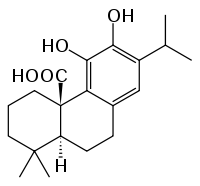Carnosic acid
 | |
| Names | |
|---|---|
| IUPAC name
(4aR,10aS)-5,6-Dihydroxy-1,1-dimethyl-7-propan-2-yl-2,3,4,9,10,10a-hexahydrophenanthrene-4a-carboxylic acid | |
| Other names
Salvin | |
| Identifiers | |
| 3650-09-7 | |
| ChEBI | CHEBI:65585 |
| ChEMBL | ChEMBL484853 |
| ChemSpider | 58635 |
| |
| Jmol-3D images | Image |
| PubChem | 65126 |
| |
| Properties | |
| Molecular formula |
C20H28O4 |
| Molar mass | 332.43 g·mol−1 |
| Except where noted otherwise, data is given for materials in their standard state (at 25 °C (77 °F), 100 kPa) | |
| | |
| Infobox references | |
Carnosic acid is a natural benzenediol abietane diterpene found in rosemary (Rosmarinus officinalis) and common sage (Salvia officinalis).[1] Dried leaves of rosemary or sage contain 1.5 to 2.5% carnosic acid.
Carnosic acid is an antioxidant and protects skin cells against UV-A radiation (photoprotection). Studies in animals have also found a protection against carcinogens.
Carnosic acid is used as a preservative or antioxidant in food and nonfood products (e.g. toothpaste, mouthwash and chewing gum -in which it has an antimicrobial effect on the microbes responsible for bad breath- or skin care products).
References
- ↑ Schwarz, Karin; Ternes, Waldemar (1992). "Antioxidative constituents of Rosmarinus officinalis and Salvia officinalis". Zeitschrift für Lebensmittel-Untersuchung und -Forschung 195: 99–103. doi:10.1007/BF01201766.